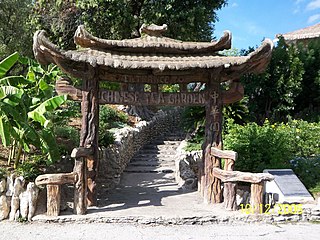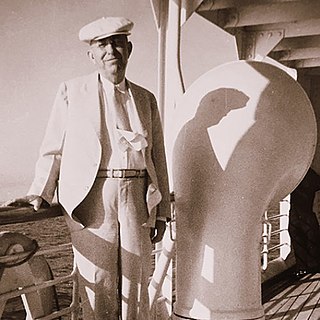
Ashley County is a rural South Arkansas county with a culture, economy, and history based on timber and agriculture. Created as Arkansas's 52nd county on November 30, 1848, Ashley County has seven incorporated municipalities, including Hamburg, the county seat and Crossett, the most populous city. The county is also the site of numerous unincorporated communities and ghost towns. The county is named for Chester Ashley, a prominent lawyer in the Arkansas Territory and U.S. senator from the state from 1844 to 1848.

North Little Rock is a city in Pulaski County, Arkansas, and the twin city of Little Rock. The population was 64,591 at the 2020 census.

The Arkansas Post, formally the Arkansas Post National Memorial, was the first European settlement in the Mississippi Alluvial Plain and present-day U.S. state of Arkansas. In 1686, Henri de Tonti established it on behalf of Louis XIV of France for the purpose of trading with the Quapaw Nation. The French, Spanish, and Americans, who acquired the territory in 1803 with the Louisiana Purchase, considered the site of strategic value. It was the capital of Arkansas from 1819 until 1821 when the territorial government relocated to Little Rock.

The Judah P. Benjamin Confederate Memorial at Gamble Plantation Historic State Park, also known as the Gamble Mansion or Gamble Plantation, is a Florida State Park, located in Ellenton, Florida, on 37th Avenue East and US 301. It is home to the Florida Division United Daughters of the Confederacy (UDC).

Philander Smith University is a private historically black college in Little Rock, Arkansas. It is affiliated with the United Methodist Church and is a founding member of the United Negro College Fund (UNCF). Philander Smith College is accredited by the Higher Learning Commission.

The Jenkins' Ferry Battleground State Park is the site of the American Civil War battle of Jenkins' Ferry, also known as the Engagement at Jenkins' Ferry, fought on Saturday, April 30, 1864, in present-day Grant County, Arkansas. The park was listed in the U.S. National Register of Historic Places on January 21, 1970, and, with seven other sites, is part of the Camden Expedition Sites National Historic Landmark, designated a National Historic Landmark District on April 19, 1994.

Dionicio Rodríguez (1891–1955) was a Mexican-born artist and architect whose work can be seen in Alabama, Arkansas, Illinois, Maryland, Michigan, New Mexico, Tennessee, and Texas, as well as Washington, D.C., and Mexico City.
The University of Arkansas Campus Historic District is a historic district that was listed on the National Register of Historic Places on September 23, 2009. The district covers the historic core of the University of Arkansas campus, including 25 buildings.
Frank Carmean was an architect in Arkansas. Not formally trained as an architect, but rather experienced in building construction, he became a designer. He joined a firm in 1927 that was developing the Edgemont residential area of Little Rock, and is believed to have designed all but one of the 16 homes in the development. The firm billed him as their "architect", and he toured to collect new designs. He introduced or expanded the use of Spanish Colonial architecture in Little Rock.

Justin Matthews (1876–1955) was an Arkansas road and bridge builder and real estate developer. He helped to design and expand many areas in central Arkansas.

The Roundtop Filling Station, in Sherwood, Arkansas, United States, is one of only two structures in Sherwood to be listed on the National Register of Historic Places, the other being Sylvan Hills Country Club Golf Course.

U.S. Highway 71 is a U.S. highway that runs from Krotz Springs, LA to the Fort Frances–International Falls International Bridge at the Canadian border. In Arkansas, the highway runs from the Louisiana state line near Doddridge to the Missouri state line near Bella Vista. In Texarkana, the highway runs along State Line Avenue with US 59 and partially runs in Texas. Other areas served by the highway include Fort Smith and Northwest Arkansas.

The Memorial to Company A, Capitol Guards was an American Civil War memorial in MacArthur Park, Little Rock, Arkansas. It stood just northeast of the former Tower Building of the Little Rock Arsenal, at a junction of two of the park's internal roadways. It consisted of a bronze sculpture depicting a Confederate Army soldier in a defensive stance, holding a rifle pointed forward. The statue was 8 feet (2.4 m) in height, and was mounted in a granite column 16 feet (4.9 m) tall. The memorial was sometimes known as "Lest we forget", a line that appeared near the top of the inscription on the base. The statue was created by sculptor Rudolph Schwarz, and was installed in 1911; it was paid for by the local chapter of the Sons of Confederate Veterans, and memorializes the unit that seized the arsenal at the outset of the war.

The Justin Matthews Jr. House is a historic house at 257 Skyline Drive in North Little Rock, Arkansas. It is a large two story Mediterranean Revival house, designed by Little Rock architect Max F. Meyer and built in 1928. It has all of the hallmarks of this style, including a red tile roof, stuccoed walls, arched openings for doors and windows, and wrought iron grillwork. The house was built for the son of developer Justin Matthews in his Park Hill development.

The Matthews-Bradshaw House is a historic house at 524 Skyline Drive in North Little Rock, Arkansas. It is a single-story masonry structure, its exterior clad in brick and stone. A conical turreted section with diamond-pane windows projects from one corner, and the gable above the main entrance is finished in half-timbered stucco. Built in 1929 by the Justin Matthews Company as part of its Park Hill development, it is the only example Matthews built of the French Eclectic style. It was designed by Frank Carmean, the Matthews Company architect.

The Matthews-Bryan House is a historic house at 320 Dooley Road, North Little Rock, Arkansas. It is a two-story masonry structure, built in the English Revival style in 1930 by the Justin Matthews Corporation as part of its Park Hill development. It has a steeply pitched gable roof, with cross-gabled entrance, and is faced in stone and brick. It was designed by Matthews Company architect Frank Carmean, and was one of the last houses built by Matthews before the full effects of the Great Depression affected his building style. As with most of Frank Carmean's homes, there are arches throughout and a full sized guest house in the rear.

The Matthews-Godt House is a historic house on the 248 Skyline Drive in North Little Rock, Arkansas. Built in 1928, it is an unusual and early example of a split-level house, a style that did not become popular until the 1950s. It is a frame structure finished in brick veneer, in the English Revival style. It was built by developer Justin Matthews as part of his Edgemont development, and was designed by his company architect, Frank Carmean.

The Park Hill Fire Station and Water Company Complex is a collection of historic public facilities at 3417-21 Magnolia Street in North Little Rock, Arkansas. The complex consists of a fire station, a water company office, two concrete reservoirs, and two stone pump houses, all built in 1938 with funding support from the Works Progress Administration. The fire station and water company office are distinguished architecturally by their fieldstone exteriors and Mediterranean style, including red tiled roofs. They were designed by the Little Rock firm of Brueggeman, Swaim and Allen.

The Park Hill Historic District encompasses the first suburban residential subdivision of the city of North Little Rock, Arkansas. It covers 172 acres (70 ha) in a geographically central part of the city, bisected by JFK Boulevard, and roughly bounded on the north by H Avenue, the west by Ridge Road, the east by Cedar Street and Plainview Circle, and the south by Crestview Drive. This area was developed beginning in 1922 by Justin Matthews, a major local developer, and greatly expanded the city's housing stock through the 1940s and 1950s. The vast majority of its architecture is residential, with commercial development limited to its major arterial roadways. The district includes Crestview Park and the Park Hill Fire Station and Water Company Complex.

The South Main Street Residential Historic District encompasses a residential area south of downtown Little Rock, Arkansas. The area, extending along South Main Street roughly between 19th and 23rd Streets, was developed between about 1880 and 1945, and includes a well-preserved set of residential architecture from that period. Notable buildings include the Luxor Apartments, the Holcomb Court Apartments, and the Ada Thompson Memorial Home.























